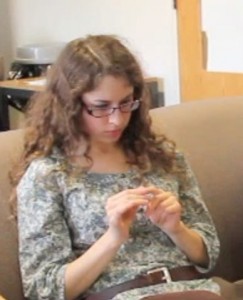Exercises for Social Initiation
 Written Exercise: When to Start a Casual Conversation
Written Exercise: When to Start a Casual ConversationFor each situation given, decide whether it would be appropriate, risky, or downright inappropriate to try to start a casual conversation with someone you don’t know. Remember that attempts to begin casual conversations with strangers may fail, even if the situation is generally appropriate! You never know if an attempt to start a conversation will work, but your chances for success are certainly greater in more appropriate situations.
#1
In a public restroom.
Our Answer
Not appropriate. In the United States, heterosexual men typically do not make conversation (or eye contact!) in restrooms. Any attempt to start a conversation here will cause discomfort and might result in a serious misunderstanding of your motives. Although it is common for female friends in the U.S. to converse in the restroom (even across stalls!), this is a sign of a previously established relationship. The restroom is generally not a place to make a new connection.
#2
You have gone inside a gas station to pay (rather than paying at the pump), or some similar service interaction (grocery-store checkout, pharmacy clerk, doctor’s receptionist, someone serving you in a restaurant, etc.).
Our Answer
Appropriate. It is certainly fine to exchange greetings with someone serving you, but be aware that if they are busy (especially if there are people in line behind you), this may be all they have time to do. If they are not busy, they may be open to exchanging further comments.
#3
You and another customer have both placed your to-go orders (in the coffee shop or the sandwich shop, etc.), and are waiting for them to be filled.
Our Answer
Appropriate. Not only do you both have a few minutes to pass, but it is quite clear that once the food arrives, you will be leaving, so there’s no fear of getting trapped in an awkward situation. You also have something in common (you both like coffee, or sandwiches, or whatever)!
#4
You and another student have both arrived early for a class (or you and another co-worker have both arrived early for a meeting).
Our Answer
Appropriate. Not only is this appropriate, it’s practically rude for co-workers or classmates NOT to chat a bit, or at least acknowledge one another in this situation, even if they haven’t previously been introduced.
#5
You and another patient are both in the waiting room at the doctor’s office.
Our Answer
Risky. Although in general, having to wait together is a great time to strike up conversations, this may be a counterexample. There are many reasons why someone at the doctor’s office may not wish to engage in even the most casual of exchanges. Depending on why they’re there, they may be worried, lost in thought, afraid or embarrassed, exhausted or in pain, emotional and/or feeling vulnerable. You can attempt non-verbal acknowledgment (catching their eye and nodding or smiling slightly), but if they look away and do not respond verbally, you’d probably do better to leave them alone.
#6
The person you want to talk to is visibly distressed (angry, crying, frowning, etc.)
Our Answer
Not appropriate. Obviously, the person is troubled just then and is not in a good frame of mind. If someone appears to be in pain, a good Samaritan might stop to ask if they can help, but this is not the time for a casual conversation.
#7
The person you want to talk to appears to be waiting for someone (checking their timepiece repeatedly, looking around, tapping their foot).
Our Answer
Risky. As in the ordering food to-go scenario, the person has some time to kill, and so may welcome some casual conversation. On the other hand, the person may be feeling quite anxious and/or angry about being kept waiting, and may not be in a positive frame of mind to engage in casual conversation. You can offer a casual comment, but if you spot signs of annoyance, be prepared to back off quickly. Even if the conversation goes well, it should be understood that you’re only filling in time until the late-comer arrives, at which point the conversation may end more or less abruptly.
#8
The person you want to talk to is singing, humming, or whistling.
Our Answer
Not appropriate. Although these behaviors generally signal a positive frame of mind, they are obvious impediments to conversation (as you cannot talk and sing/hum/whistle at the same time). Apart from public concerts, people generally engage in these behaviors when they are alone. Doing it in front of you is as good as saying, “I don’t want to talk.”
#9
The person you want to talk to is walking a dog.
Our Answer
Depends on how you feel about dogs! If you are a dog-lover and this is a friendly dog, then this is a great opportunity. Even if the dog-walker is in a hurry, they will appreciate a compliment to their dog (“What a beautiful dog!”), and one can ask all sorts of questions about the dog that the owner will not find threatening (“What breed is he? How old is he?” etc.) Remember: never pet a strange dog without asking the owner first! If you have your own dog to take for a walk on a nice day (or can borrow a friend’s dog (or a baby to push in a stroller)), you will find that all sorts of people will initiate conversations with you, as long as you maintain a happy, friendly look.
#10
The person you want to talk to is a friend of a friend (or a friend of a family member of yours, or a family member of a friend of yours, etc.).
Our Answer
Appropriate. Even if you haven’t been introduced by your mutual acquaintance, this connection entitles you to introduce yourself. As long as their connection with the mutual friend is a positive one, it practically guarantees that they’ll be polite to you. Don’t make the mistake of seeming to know too much about them, though, as this may seem a bit creepy, and also make them think that the mutual friend has been indiscreet. Rather, approach them with questions (“Aren’t you my friend Jackie’s friend from school?”) and hedging (“I think she said you were working in real estate now, right?”).
 Written Exercise: Opening Lines
Written Exercise: Opening LinesWhich comments would or would not be appropriate if you’re trying to start a friendly, casual conversation with someone you don’t know? Please bear in mind that these are NOT intended to be prescriptions for what you should say in the given instances, just discussions of why the strategy may or may not be generally successful. You need to choose comments that work for you!
#1
(It’s raining or threatening to rain, and the person is carrying an umbrella): “I wish I had remembered
my umbrella!”
Answers
Appropriate. This does not demand a response, alludes to the weather (which is always safe), and is even a bit flattering to the other person (as it implies “you’re smarter or more organized than I am”).
#2
(It’s not raining, and the person is carrying an umbrella): “There’s no rain in the forecast, you know.”
Answers
Risky. Although the weather is generally a safe topic, this may come across as a challenge (as it seems to imply “you’re doing something dumb”). It may be that the person will be willing to sheepishly admit that they were wrong, or will happily explain to you that they’re returning it to a friend (or just found it under their chair, or whatever) – but it’s also possible that they will take offense, and think you’re rude.
#3
(The person is wearing a tee shirt advertising a band or team): “That band (or team) sucks!”
Answers
Not appropriate. If you’re trying to be friendly, you don’t want to tell someone that they have terrible taste in music (or clothes, or anything else). You don’t have to lie and pretend to like things you don’t, but you can keep negative opinions to yourself until you know each other better.
#4
(The person is wearing a teeshirt advertising a particular city or country): “Have you been to (that city or country)?”
Answers
Risky. In some sense, any writing on someone’s clothes can be considered a conversational opener – you’re just responding to what they “said” (in writing). It would be appropriate to say “I love that place,” or “I’ve always wanted to go there.” Admitting that they have or haven’t visited a particular place is not a terribly personal thing, and some people won’t think anything of it, but some people might be nervous if you begin asking them questions about themselves right away. You’re much safer with a comment than with a question.
#5
“Wow, your hair is so long!”
Answers
Risky. Commenting (even positively) on someone’s physical attributes is generally not a good idea (until you’ve gotten to know them a bit better). While some people may be very proud of this feature, and beam with pleasure at the compliment, it could also come across as creepy, as an expression of sexual interest, as judgmental in some way.
#6
“I like your shirt.”
Answers
Risky. This may be misinterpreted as flirting. It may be okay if the shirt (or shoes or hat or whatever) is in some way unusual and you are sincere (not sarcastic) about liking it. If the item is perfectly ordinary, you will appear sarcastic. Make sure compliments are made very casually (so they don’t imply an unhealthy level of interest or sexual attraction). In some cultures, expressing admiration for someone else’s belongings would force that person to give the admired object to you, lest they incur the ‘evil eye’ – but this is generally not an issue in the U.S.
#7
You’re both waiting for a bus: “This freaking bus is always late! It drives me crazy.”
Answers
Inappropriate. Expressing anger is threatening: how do we know that you can control it? You might pose an actual, physical danger to me! Saying “Late again!” with a gentle sigh and a wistful smile would be fine (this would be a “shared gripe,” rather than an emotional outburst).
#8
You’re both waiting for a bus: “Nice day.”
Answers
Appropriate, whether it is sincere (sharing enjoyment of pleasant weather) or sarcastic (sharing a common, gentle gripe about unpleasant weather).
#9
You’re both waiting for a bus: “Do you take this bus often?”
Answers
Inappropriate. This is too direct and personal; you might sound like a stalker. A less direct question like “Does this bus usually run on time, do you know?” would be okay, giving them the opportunity to volunteer information such as “Usually” (showing that they take it often) (or “I don’t know, I don’t usually take this one”), or to give a more ambiguous response (like a shrug).
#10
“You look familiar. Haven’t I seen you somewhere before?”
Answers
Inappropriate. Again, this may seem threatening as an opening line (or like you’re trying to flirt). After you’ve engaged in pleasant conversation for a minute or two, it would be okay to bring this up. If you really have crossed paths in other places, you will have other things in common that you can then talk about.
 Photo Exercise: Open and Closed Postures
Photo Exercise: Open and Closed PosturesFor each photo, say whether the person’s body language is open (and thus they might be willing to engage in small talk) or closed (sending the signal that they do not want to interact). If the person appears to be looking at someone or something off-camera, read the photo as if they were making eye contact with you. Facial expressions can be fleeting, and postures may be ambiguous, so you may find these photos hard to “read” without further context. If this is the case, consider what information you would be looking for to help you figure out the social signals that are intended.
#1

Answer
He appears to be focused on studying. The posture is hunched, and the arms (while not technically “crossed” — because it would be hard for him to study with crossed arms!) seem to form a protective barrier around his body. If he maintained this pose without looking up upon your approach, it would be a clear signal that he did not wish to interact.
#2

Answer
You should see the difference between this photo and the previous. Here, he is sitting slightly back, with one arm back, creating a much more open posture. He is not even looking down at the book. You should feel comfortable greeting him.
#3

Answer
She seems like she’d be willing to talk to him (touching her hair, and looking at him), but he is sending a clear signal that he does not wish to engage in conversation. His body is turned away from hers, his arms again appear to form a protective barrier, and he keeps his head down.
#4

Answer
He’s sending a clear signal that he would like to talk to her: his body is angled towards her and is completely open (not hunched, arms spread –one arm is even extended towards her). He’s even looking at her book rather than his own! (He might be trying to see what she’s reading to get an idea of what he can talk to her about — e.g., “oh, is that Chemistry you’re studying?”) If she maintains her current pose (not letting him catch her eye, even though she’s certainly aware of what he’s doing via her peripheral vision), it will send a clear message that she does not want to engage in social interaction. If she glances up with a social smile (however briefly), he will take that as permission to begin a conversation.
#5

Answer
She looks bored (playing with her fingers), but her posture remains relatively open — she might welcome some conversational distraction. If you approached her and she glanced up at you with a social smile (however briefly), this would be a confirmation of that. If, however, when you approached, she intensified her scowling expression and/or hunched her shoulders and/or pretended to be really absorbed in her self-grooming activities, this would be a warning to back off.
#6

Answer
Her body posture is open (legs crossed comfortably). The gesture (index finger up along the cheek, the chin resting on the remaining fingers) is one that someone might adopt if sitting alone, bored. Noticing your approach, she has looked up and is smiling (faintly — she doesn’t know you, after all!). She is inviting conversation.
#7

Answer
It’s hard to read too much social intention into someone adjusting her hair. This is obviously a fleeting pose, not really intended to communicate. On the other hand, her body language remains open and comfortable, so you’d want to see what she does when she’s finished adjusting her hair: does she look up and make eye contact (inviting conversation)? Or does she pretend she hasn’t noticed your arrival (telling you that she’s not interested)? Does she keep her posture open and comfortable, or does she assume a cross-armed and/or hunched-over posture?
#8

Answer
Sitting cross-legged like this is generally a sign of being comfortable (if one is able to do it at all). Her arms are not so much crossed (to protect herself) as they are resting comfortably in her lap. She appears to be gazing off into space (not making eye contact with anyone), but she is smiling faintly. I’d feel comfortable striking up a conversation with her.
#9

Answer
The posture here is somewhat ambiguous, but check out the facial expression! If I were approaching someone and she gave me a look like this, I’d back off in a hurry!
#10

Answer
She is sitting back comfortably (leg crossed casually, arms resting). She appears to be looking off into space, presumably a bit bored, but with a hint of a smile. I would feel comfortable greeting her, and if she returned eye contact with a reciprocal greeting, I’d feel comfortable interacting further.
 Video Exercise:
Video Exercise:In this video, we see a successful attempt to strike up a conversation. How does each person signal that they are willing to engage in conversation?
Answers
It goes by really fast in real life (conversation does!), but if you pause frame-by-frame, you’ll see that he has an open posture to start with.

She’s looking directly at him as she approaches (checking him out pretty carefully).
He feels her eyes upon him, and looks up to check her out just as she looks down at her bag.
When she looks toward him again, they make eye contact very briefly, and that’s when he is encouraged to greet her.
He asks her “Am I in your way?” (even though he was there first!) to emphasize that he doesn’t wish to impose on her, that he’s not any sort of threat. Her answer (“Oh, no, you’re fine,” gesturing briefly towards him) indicates that she’s comfortable sitting next to him — and therefore also comfortable chatting with him. Even though she keeps her answers very brief, there is no sense that she’s trying to discourage him.
 Role Play/ Video Modeling Exercise:
Role Play/ Video Modeling Exercise:For each role play (and you should try several), your confederate will decide in advance whether they are open to having a conversation (but will not share this information with you). You should approach them with a greeting or a comment – a different one each time. Try to both practice the suggestions we’ve included here and come up with your own! Can you “read” your confederate’s response appropriately? Even if the conversational ‘bait’ is not taken, does your confederate feel that you were projecting a friendly (not creepy) vibe?
For best results, you should always videotape role play exercises, so you can see exactly what your role play partner saw, and understand why they got a positive or negative impression of you. You can watch multiple times, each time focusing on a different aspect: what you said, your eye contact, how far/close you were, your tone of voice, etc. Don’t obsess over your missteps, but do keep the videos where you did an excellent job, so you can re-watch them multiple times. This not only helps you to improve your skills, it also builds confidence!)
 Practice Exercise: Real Life
Practice Exercise: Real LifeGo out and make small talk with people! (If you have a friend who can come along with you, that might be best at first, to make sure you don’t get into awkward situations.)
 Written Exercise: When to Start a Casual Conversation
Written Exercise: When to Start a Casual Conversation Written Exercise: Opening Lines
Written Exercise: Opening Lines Photo Exercise: Open and Closed Postures
Photo Exercise: Open and Closed Postures






 Video Exercise:
Video Exercise:



 Role Play/ Video Modeling Exercise:
Role Play/ Video Modeling Exercise: Practice Exercise: Real Life
Practice Exercise: Real Life

